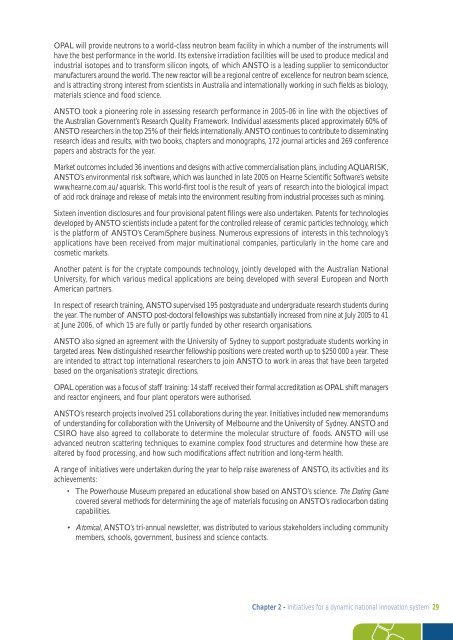The Australian Government's Innovation Report
The Australian Government's Innovation Report
The Australian Government's Innovation Report
You also want an ePaper? Increase the reach of your titles
YUMPU automatically turns print PDFs into web optimized ePapers that Google loves.
OPAL will provide neutrons to a world-class neutron beam facility in which a number of the instruments will<br />
have the best performance in the world. Its extensive irradiation facilities will be used to produce medical and<br />
industrial isotopes and to transform silicon ingots, of which ANSTO is a leading supplier to semiconductor<br />
manufacturers around the world. <strong>The</strong> new reactor will be a regional centre of excellence for neutron beam science,<br />
and is attracting strong interest from scientists in Australia and internationally working in such fields as biology,<br />
materials science and food science.<br />
ANSTO took a pioneering role in assessing research performance in 2005-06 in line with the objectives of<br />
the <strong>Australian</strong> Government’s Research Quality Framework. Individual assessments placed approximately 60% of<br />
ANSTO researchers in the top 25% of their fields internationally. ANSTO continues to contribute to disseminating<br />
research ideas and results, with two books, chapters and monographs, 172 journal articles and 269 conference<br />
papers and abstracts for the year.<br />
Market outcomes included 36 inventions and designs with active commercialisation plans, including AQUARISK,<br />
ANSTO’s environmental risk software, which was launched in late 2005 on Hearne Scientific Software’s website<br />
www.hearne.com.au/aquarisk. This world-first tool is the result of years of research into the biological impact<br />
of acid rock drainage and release of metals into the environment resulting from industrial processes such as mining.<br />
Sixteen invention disclosures and four provisional patent filings were also undertaken. Patents for technologies<br />
developed by ANSTO scientists include a patent for the controlled release of ceramic particles technology, which<br />
is the platform of ANSTO’s CeramiSphere business. Numerous expressions of interests in this technology’s<br />
applications have been received from major multinational companies, particularly in the home care and<br />
cosmetic markets.<br />
Another patent is for the cryptate compounds technology, jointly developed with the <strong>Australian</strong> National<br />
University, for which various medical applications are being developed with several European and North<br />
American partners.<br />
In respect of research training, ANSTO supervised 195 postgraduate and undergraduate research students during<br />
the year. <strong>The</strong> number of ANSTO post-doctoral fellowships was substantially increased from nine at July 2005 to 41<br />
at June 2006, of which 15 are fully or partly funded by other research organisations.<br />
ANSTO also signed an agreement with the University of Sydney to support postgraduate students working in<br />
targeted areas. New distinguished researcher fellowship positions were created worth up to $250 000 a year. <strong>The</strong>se<br />
are intended to attract top international researchers to join ANSTO to work in areas that have been targeted<br />
based on the organisation’s strategic directions.<br />
OPAL operation was a focus of staff training: 14 staff received their formal accreditation as OPAL shift managers<br />
and reactor engineers, and four plant operators were authorised.<br />
ANSTO’s research projects involved 251 collaborations during the year. Initiatives included new memorandums<br />
of understanding for collaboration with the University of Melbourne and the University of Sydney. ANSTO and<br />
CSIRO have also agreed to collaborate to determine the molecular structure of foods. ANSTO will use<br />
advanced neutron scattering techniques to examine complex food structures and determine how these are<br />
altered by food processing, and how such modifications affect nutrition and long-term health.<br />
A range of initiatives were undertaken during the year to help raise awareness of ANSTO, its activities and its<br />
achievements:<br />
• <strong>The</strong> Powerhouse Museum prepared an educational show based on ANSTO’s science. <strong>The</strong> Dating Game<br />
covered several methods for determining the age of materials focusing on ANSTO’s radiocarbon dating<br />
capabilities.<br />
• Atomical, ANSTO’s tri-annual newsletter, was distributed to various stakeholders including community<br />
members, schools, government, business and science contacts.<br />
Chapter 2 - Initiatives for a dynamic national innovation system 29












![[Tam] Uygula[ya] - Bilim, Teknoloji ve Ä°novasyon Politikaları TartıÅma ...](https://img.yumpu.com/36820041/1/184x260/tam-uygulaya-bilim-teknoloji-ve-anovasyon-politikalara-tartaama-.jpg?quality=85)



